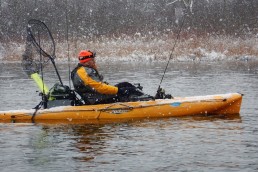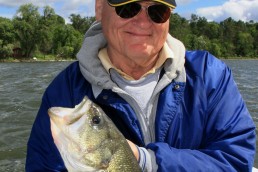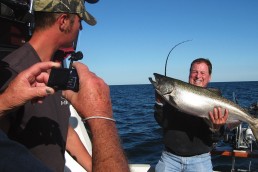Clothing Options for Cold-water Kayak Fishing
SHARE THIS POST
It’s April—the birds are singing under a sunny sky and a warm southerly winds are puffing as you paddle your kayak out. You are ready to start fishing. Everything is wonderful until you reach back behind for something in your tackle crate, and then put way too much weight one one side. Suddenly, you’re in 50-degree water, which triggers what the emergency medical technicians call the “cold shock response.” The shock of the water causes you to involuntarily inhale it, and now you’re in real trouble. Fact is, you’re well on your way to drowning, or maybe you fell in and your head is above water, but, still, when that frightened response occurs, you inhale air instead of water. Your head’s dry, but you’re still soaked to the bone below and your body’s rapidly losing heat, causing you to shiver from exposure and you get disoriented. The air temperature is 40, the wind is blowing and the clock is ticking. If you don’t get out and get warm and dry very quickly, you lose consciousness.
All water sportsmen have heard of hypothermia—and it’s no picnic, and very serious.
But if you dress for the possibility of accidentally going into a lake or river, you’re probably just going to be embarrassed if you take a proverbial dunk. You’ll live to tell the tale, and only end up having to tell your buddies to stop talking about how funny it was to watch you fall in the lake.
There’s a kayaking rule of thumb: you should wear clothing that protects you from cold water any time the temperatures of the water and the air add up to less than 120 degrees. And that’s the whole month of April. Most kayakers will tell you that a dry suit is the best way to go, unlike the bulky scuba-diving wet suits made of thick neoprene. The dry suits for kayakers are lightweight with a fabric much like that Tyvek stuff used for super-tough envelopes or for making a moisture barrier under the siding of a new house. A dry suit’s fabric is breathable so it doesn’t turn into a “sauna” suit. And some dry suits are even made with Gore-Tex.
I paid $700 a few years ago for a dry suit, and even though that seems like a lot of money, it was actually an entry-level model. You can easily spend up to $1,200 or and more for a new, quality dry suit. So far, I feel like it’s been money well spent, although I haven’t needed to “test” it to see if it would keep me alive. And with the right amount of layers underneath, my dry suit keeps me warm and comfortable from 15 up to about 60 degrees, making me pretty confident that it will stave off any chances of hypothermia—I’ve waded in water up to my waist while wearing it in 38-degree water and my legs and toes stayed toasty.
The first time I wore it, though, I made the mistake of thinking it would be warmer than it turned out to be. I wore long johns and a sweatshirt and sweat pants—two layers—underneath, and that wasn’t enough. While steelhead fishing with a buddy in his aluminum jet sled, I got downright cold even though I didn’t get wet. But now I think I have the layers pretty well figured out. A first layer of a GHUnders long-sleeve shirt and what the company calls “tights” for the bottoms works great, and better than any long underwear I’ve ever worn. Designed for hunting and fishing in the cold and clammy Pacific Northwest, these clothes insulate, and wick away perspiration. They are expensive at $150 for tights and the top combined, but they do work exceptionally well. Also, for extra leg warmth I’ll wear a set of Cabela’s fleece wader pants over the GHUnders and a pair of basic sweatpants over the wader pants.
Are you enjoying this post?
You can be among the first to get the latest info on where to go, what to use and how to use it!
Ghunders’ socks under wool socks keep my tootsies warm. Above my waist, I’ll add a thermal long-sleeve undershirt over the GHUnder long-sleeve shirt, and add a thick, crewneck sweatshirt over that. These layers have kept me comfy even in 15-degree air temperatures.
Another option many kayakers prefer is a pair of waders with insulating layers for your bottom half and a “dry top” for the upper. This is basically half of a dry suit with a tight, wide cummerbund, sort of a belt that seals the water out. I’ve not tried one but some guys say this setup isn’t quite as dependable for keeping water completely out as your one-piece dry suit-jumpsuit combo. However, many guys love them. A big advantage of this latter ensemble is it’s a lot easier to put on if you’re older, or an overweight kayaker such as myself. The first time I tried to squeeze myself into my new dry suit I actually contemplated the irony of having a heart attack while putting on the life-saving suit—it’s not easy. That first time took an hour, but now I can get in it in about 15 minutes. If you get a dry suit, go search on YouTube for the videos that show you how to put it on. Those videos could “save your life” from an aneurysm or stroke before the suit even has a chance to keep you from exposure to cold waters. (About dry suit footgear—you need it too. Dry suits have rubber booties that seem like they could rip if a sharp stone just looked at them. A a pair of “wet shoes” online from NRS company and others have neoprene tops and thick-treaded soles and work well.)
Do I really have to mention that you should wear a life jacket when fishing from a kayak in cold water? I hope not. You should wear a PFD all the time when fishing in a kayak, no matter the air temperatures or month. Last fall, I switched to a more conventional life jacket. And in colder waters, it’s best to wear a traditional foam life vest. You really don’t want to be groping for a ripcord from some inflatable jackets after you’ve sucked in a double lungful of cold water and your dexterity has been compromised. Modern life vests are more comfortable with every new product introduction, and some are awesome for kayak fishing, featuring big, zippered pockets that keep fishing tools and small tackle packs handy.
One final suggestion: always fish spring coldwater bodies of water with a buddy. Getting back into a kayak in the middle of a lake is about 10 times easier if someone is there in another kayak ready to keep your boat steady while you slither up and clamber back aboard.
Angling waters in much of the Midwest in April can put you under a blazing sun or put you amidst a windy late-winter front or early spring snowstorm. One thing for sure is that the water is likely to be cold enough to be deadly. Prepare for the worst, and wear a dry suit or waders and dry top combo, and, hope you never have to find out if it works.
MWO
SHARE THIS POST
Did you enjoy this post?
You can be among the first to get the latest info on where to go, what to use and how to use it!
Dave Mull
Dave Mull of Paw Paw, Mich. has spent his career communicating the outdoors experience and runs Inner Viking Media. He enjoys kayak fishing for anything that swims in the lakes and rivers of the Midwest and beyond, and even uses his MirroCraft, from time to time. Available for seminars.



